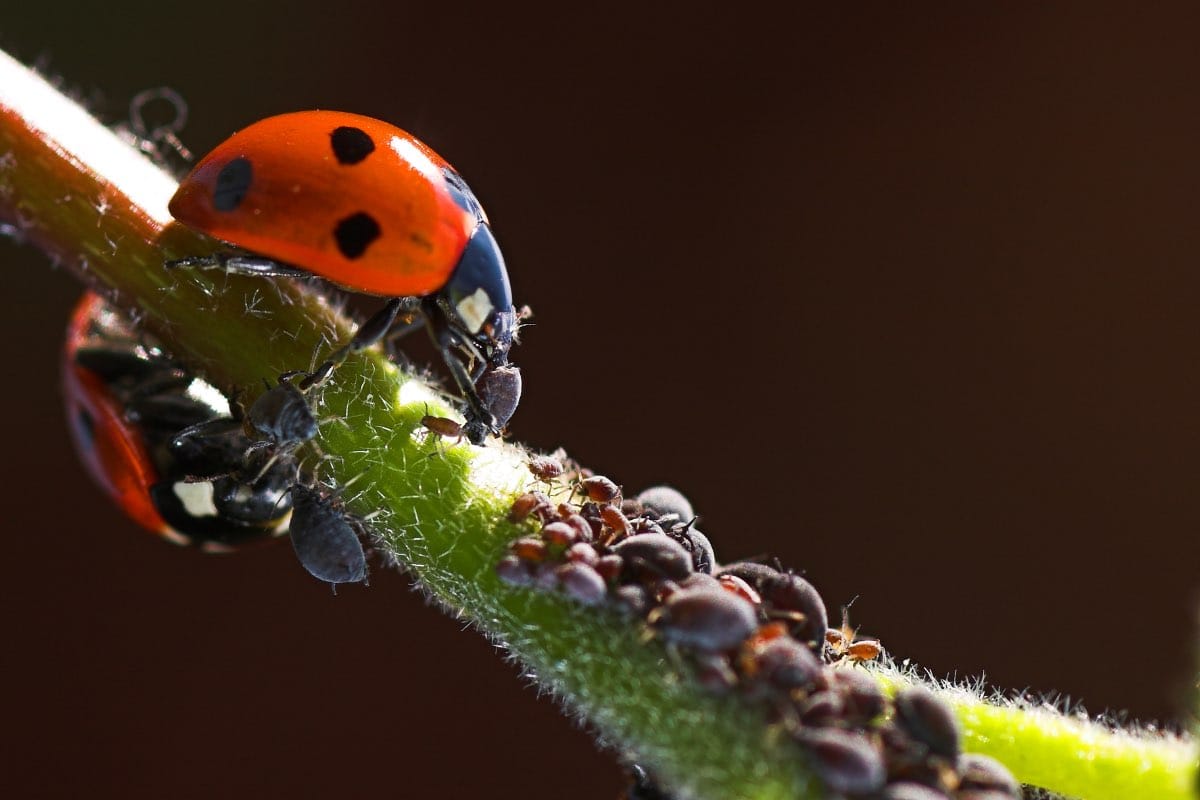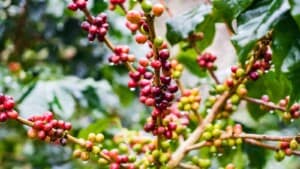Have you ever spotted little black bugs on your plants?
Black aphids seem to find a way to our plants in one way or another.
Also known as melon aphids, black aphids are oval-shaped tiny insects that multiply quickly and could potentially harm your plants as they suck the sap out of them.
Fortunately, plenty of ways exist to control this common plant pest.
What are Black Aphids?
Black aphids (Aphis fabae) are tiny insects that measure up to ⅛ inches long. These little dark insects cling, pierce and suck the sap out of plants.
They have been nicknamed blackfly, black bean aphids, and beet leaf aphids.
Their favorite plants to feed on are runner beans, nasturtiums, chamomile, viburnum plants, thistles, celery, and poppies.
Aphids are tiny, so they often go unnoticed at first. But besides spotting them on our plant’s leaves, you may also spot them by the honeydew residue they leave behind on the leaves. They feed on plant sap using their needle-like mouths.
Some aphid species (including black aphids) do not need a partner to reproduce, as they can quickly increase their population; this is why few aphids can become hundreds of aphids in less than a week.
Female aphids give birth to other females (nymphs) who are born pregnant. Given their incredible adaptation, this pest’s chances of exponential growth in a short time are incredibly high.

Identifying Aphids
Adult aphids generally have pear-shaped bodies with long antennas, yet they are often invisible to the naked eye.
Young aphids (nymphs) resemble adults, but most species have two cornicles (short tubes that project from their posterior).
Adult aphids are usually wingless. However, they can grow wings when their population becomes crowded. When their food sources have been diminished, they can travel to new plants, reproduce, and start a new colony.
Aphids generally feed on a wide variety of plants. However, some species are specific to certain plants, like bean aphids, potato aphids, melon aphids, woolly apple aphids, cabbage aphids, and green peach aphids.

Biology & Life Cycle
- Winter: Overwinter as eggs on Viburnum (snowball bush) and Euonymus (burning bush).
- Spring: Before giving birth to winged females, asexual wingless females spend two to three generations on winter hosts.
- Summer: Colonizing flights to summer hosts (corn, beans, sugar beets, lamb’s-quarters) have explosive growth and multiple generations (asexual wingless females).
- Fall: Asexual winged females and winged sexual males return to winter plant hosts and have one generation of sexual females to lay and hatch eggs.

Aphids Natural Enemies
- Green lacewings: voracious aphid predators that feed as larvae.
- Brown lacewings: similar to green lacewings but smaller, there are frequently found on trees.
- Hoverflies: these insects resemble honeybees but are slug-like.
- Aphid midge: tiny fungus gnat-like adults that are bright orange. They inject toxins into the aphid’s legs and suck their body insides.
- Lady beetles: both adults and larvae feed on aphids.
- Minute pirate bugs: tiny patterned black and white adults that feed on small aphids.
- Parasitic wasps: eggs are laid in the aphid, and the larvae consume it from the inside out. Then the aphid transforms into a hardened shell that’s called a mummy. The wasp pupates inside the mother and later emerges.

Aphid Damage & Symptoms
As previously mentioned, aphids feed on the plant’s sap, which weakens them and reduces their growth. But aphids can also carry and transmit viruses from plant to plant, causing leaves or stems to curl up or distort their shape. This virus infects many common crops, such as spinach, tomato, lettuce, broad beans, and celery.
Aphid colonies usually live underneath leaves, growth points, or on flowers. As they suck the sap, they release honeydew which makes the leaves develop a shiny glaze.
Although ants do not feed on aphids, they collect the secreted honeydew.
In damp conditions, sooty mold can grow on the honeydew; besides being unsightly, it can gradually deprive the leaf of light and eventually kill the plant.
These tiny insects shed their skins as they grow. Their skins gather on leaves surfaces below where they’re feeding and form a speck of whitish dust; this is often the first sign of an aphid infestation.

Indirect Effects of Black Aphid Infestation
Apart from the plant’s growth likely being stunted and losing nutrients, there are other implications of a Black Aphid infestation.
The honeydew that aphids secrete is not harmful to the plants, although it attracts the growth of sooty mold and other harmful pests to your plant.
Sooty mold is a dark-colored fungal growth that is not technically a disease but a hindrance to your plant’s health. This mold covers the leaves and can engulf them, depriving the plant of light and slowing down food production and photosynthesis.
Sooty mold also turns the leaves yellow and sometimes kills them, causing premature leaf drop and, eventually, plant death.
Black aphids are the most common virus vector pests that can infest plants with over 30 fatal viral infections because this type of aphid has specifically designed stylets that puncture the plant’s outer wall, which promotes virus transmission. Although these tiny insects are not directly the source of the virus, they can transmit viruses from plant to plant.

How To Control Black Aphids
Different ways to control an aphid infestation exist, from organic to chemical pesticides. Choosing the proper method depends on the extent of the infestation and on whether you prefer a natural or chemical approach.
Water Approach
Take your plant outdoors and rinse off all aphids using a solid blast of water. Use caution so you don’t damage your plant.
Spraying soapy water is also a good option. This is a great natural way to remove aphids, although you may have better choices if you have delicate plants.
Ultra-Refined Oil Sprays
Many stores sell concentrates oils that are plant-safe when applied correctly.
These oils suffocate the aphids and prevent them from feeding off the plant. Most horticulture oils are plant-safe, but delicate plants may still be sensitive.
If you use this method, spray outdoors only.
Pesticide Sprays
There are numerous commercial chemical pesticides explicitly made for black aphids.
The best plant-safe natural pesticides on the market are neem oil sprays, natural insecticides, insecticidal soap sprays, and food-grade diatomaceous earth.
Aphids Predators
Plant flowers like calendula, daisy, dill, marigolds, alyssum, or sunflowers attract beneficial insects, which are aphid predators.
Lacewing larvae and ladybugs are the most effective at devouring this pest.
Other Pest Control Guides from Planet Natural:
Aphid Control: How to Get Rid of Aphids Effectively at Home











